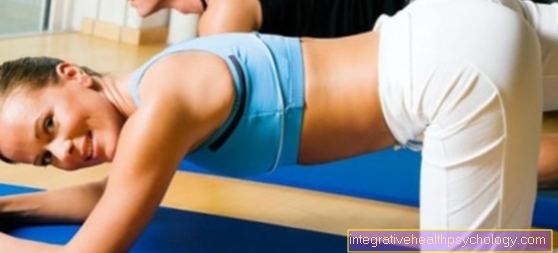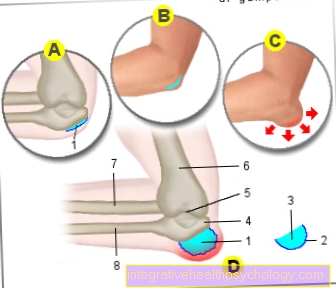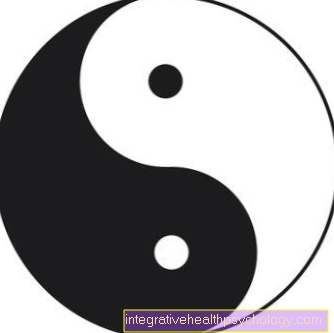Postnatal exercise
introduction
Postnatal gymnastics are various exercises that women can start a few weeks after giving birth to strengthen the stressed pelvic floor and abdominal muscles.
During pregnancy, the pelvic floor must support the weight of the growing child, the weight of the amniotic fluid and placenta, as well as the mother's organs.
During the birth, the pelvic floor is once again heavily stressed and stretched and sometimes injured by the exiting child.

The tone of the muscles can be reduced by pregnancy and childbirth, so it increases Incontinence and one Lowering of the uterus can come. For example, many women have difficulty holding urine when they laugh or cough after giving birth.
Postpartum gymnastics is therefore a very important component in the postpartum phase, which can help to strengthen the muscles of the pelvic floor again and reduce incontinence and Uterus subsidence to prevent.
However, the pregnant woman is not allowed to start immediately after giving birth, as birth injuries heal first and the body needs to recover from birth.
Exercises
As part of the Postnatal exercise Many different exercises can be done with the goal of that To strengthen the pelvic floor muscles again.
For example, many exercises come from the area of yoga. The exercises can either be done in groups at special Regression courses or can also be carried out at home. The woman can decide this for herself individually.
It is important that the woman finds a solution that suits her and the training regularly and consistently to achieve the best possible result. Here are some sample exercises:
Cat hump
During this exercise, the woman goes into the QuadrupedSo place your hands and knees on the floor. The feet rest with the backs of the feet on the floor. The back is now first bent and then pushed upwards; the woman goes into a cat's hump.
It is best to imagine that one is the Belly button inwards towards the spine as far as possible want to pull.
The head is lowered at the same time and the gaze wanders towards the stomach.
Hold this position for a few seconds, then bend your back again. This sequence of movements is repeated a few times.
Arm-and-leg lifters
In this exercise, the woman lies on her stomach with her arms stretched forward and her toes placed on the floor. Now are always at the same time the left arm and the right leg and then lifted the right arm and left leg off the floor.
A slight lifting is enough. Hold the position briefly before changing sides.
If this exercise is too difficult, the arms can also be excluded from the exercise. Then only the legs are alternately lifted off the ground.
Pelvic floor tension
This exercise can in almost every everyday situation to be built in. To do this, the pelvic floor maximum tension for a few seconds, as if trying to stop the urine stream while urinating.
The tension should be held for about 10 seconds before releasing again.
Tension and relaxation phases should be alternated 3-5 times in a row. The exercise can be repeated any number of times a day.
Draw circles in the air
For this exercise, the woman lies on her back with her legs stretched out. The legs are now closed and lifted upwards so that an approximately 90 ° angle is created. Now with your legs straight draw large circles in the air. The direction can be changed several times. After about ten circles, the legs are put down again.
Knee-arm transducer
In these exercises, the woman kneels upright, the knees are in a position about hip-width apart, the toes are raised, the lower legs and thighs are at a right angle to each other. The bottom is now lowered a little towards the feet and parallel to the Pelvic floor tense. The woman should go down as far as she can hold the position. The arms are then swung to one side and then to the other.
In this position, the pelvic floor is forced to compensate for the movement and is effectively strengthened. After a few seconds, lift your buttocks back to the starting position and relax.
Postnatal exercise at home
Postural gymnastics can also be done very well at home. Attending a course is not absolutely necessary.
The above exercises are very suitable to be performed at home, as they can be easily integrated into everyday life.
Special Yoga workouts be performed. These can also be completed at home, for example with an online program.
However, it is important that only exercises are performed that are intended for the Postpartum period are suitable.
Exercises that do the Abdominal and pelvic floor muscles Too much and unfavorable stress are not conducive to Continence and Preservation of the pelvic floor stability.
Postnatal exercise after a caesarean section

Postnatal gymnastics after a Caesarean section may only be started when the wounds have healed sufficiently. This is after about eight to twelve weeks the case and should have been checked by a doctor.
Even if the pelvic floor is not stressed as much during a caesarean section as during a natural birth, postnatal gymnastics is still highly recommended. The abdominal muscles and the pelvic floor have been stressed and strongly stretched by the previous pregnancy, so that targeted training should restore and maintain the stability of the muscles.
If, from a medical point of view, recovery gymnastics can be started, training should be started carefully and carefully so as not to overstrain the healed tissue.
It makes sense to start with the pelvic floor and only after that Abdominal and buttock muscles to train. In this way, stability is restored from the bottom up, so to speak.
When and how long should postnatal exercises be carried out?
The postnatal exercise can usually be started after about four to six weeks after a vaginal delivery or eight to twelve weeks after a caesarean section.
The beginning of the training depends largely on the birth injuries suffered by the woman. These should first be healed before starting the exercises, because a healed tissue is a prerequisite for the rebuilding of the muscles.
How long you should continue with the training varies from person to person. Depending on the fitness level of the woman, the basic requirements of the muscles can vary greatly, so that it also takes a different amount of time until sufficient stability of the muscles is achieved.
Depending on the health insurance company and how it is covered, it is required that postnatal gymnastics be completed within nine months of the birth.
Since postnatal gymnastics can generally not do any harm, it is better to continue it over a longer period of time and then gradually switch back to a daily sports program (as before the pregnancy).
With the following topic you will learn more interesting information not only about postnatal gymnastics, but also everything about the courses after childbirth. Read about this under: What postnatal courses are there?
Postnatal exercise in the puerperium
For the time of Puerperium will still no postnatal exercise recommended.
The exercises should no earlier than the sixth week after the birthcan be started even later in the case of a caesarean section. The reason is that the Birth injuries must heal first and allow the body to recover from the strains of pregnancy and childbirth.
However, there are women who, very soon after giving birth, find themselves able to do something for their bodies again. For these women there are gentle exercises that gently stimulate the pelvic floor again and promote muscle building.
For example, while sitting or lying down, the pelvic floor can be tensed for a few seconds several times a day and then released again.
The Mobilization of the pelvis is also something that can be done well in the puerperium.
To do this, you can bend the pelvis in all directions and, especially when lying down, make sure that the sacrum and lumbar spine are always pressed against the surface for a short time in between. This compensates for the hollow back that often arises during pregnancy and mobilizes the vertebrae as well as the sacrum and coccyx region.
Exercise in the puerperium should definitely be used taking into account the condition of the mother. It is not an absolute must.
Postnatal exercise with the baby
Many postnatal gymnastics courses can also together with the baby be visited.
With these courses there is either the possibility of childcare or the babies will involved in the exercises.
Various exercises can also be done at home to help the baby recover. This then not only promotes the Muscle building in the mother, but also the Bond between mother and child.
Exercises
One possible exercise with a baby works as follows: The mother lies on her back and puts her legs up in front of the pelvis. The baby is sitting on the mother's lower abdomen, she holds it in her hands. Now the mother pulls hers Belly button strong inwards and exhales.
The bottom is raised, until your thighs and back are in a straight line. This position is held for a few seconds, then the pelvis is lowered again. This sequence of movements is repeated a few times.
Another exercise involving the baby works like the classic one Ladies push-ups. The baby lies on the floor in front of the mother. The mother goes into the ladies push-up position, kneeling in front of the baby and supporting her hands on the right and left of the baby. Now she goes down with her upper body so far that she can give her baby a kiss and then pushes herself up again. This is repeated several times.
One last possible exercise with baby specifically trains them Abdominal wall. The mother lies flat on her back and places her baby on her stomach. Then she exhales vigorously and pulls her navel all the way in. Then she inhales deeply into her stomach and pushes the abdominal wall out so that the baby is rocked upwards. Repeat this process a few times in a row.
Postnatal gymnastics despite renewed pregnancy
If it is still during the period of regression to one renewed pregnancy comes, the question arises whether the postnatal exercise can be continued.
The Pelvic floor training should definitely be continued, as a stable pelvic floor is a prerequisite for it to be able to withstand and carry the new pregnancy.
The training must of course be adapted to the state of health and general well-being of the pregnant woman.
Exercises that put a lot of strain on the abdominal muscles should be avoided in this case.
An adequate one Pelvic floor training and light endurance training However, they are highly recommended and do not pose any disadvantages or risks for the existing new pregnancy. Swimming, for example, is suitable as a light endurance training.
If you are unsure, there is always the option of consulting an experienced midwife or doctor.
Health insurance benefits
Whether and how much the health insurance company pays for a postgraduate course varies greatly.
For example, some health insurance companies cover the costs of up to ten group lessons a postgraduate course. If you register in good time, you may be entitled to the full coverage of the costs by the health insurance company.
It is often required that the postnatal gymnastics then within nine months of delivery is completed.
You should clarify individually by telephone whether your health insurance company bears the costs for postnatal gymnastics. The on-site employees can provide information about this quickly and easily.












.jpg)
















